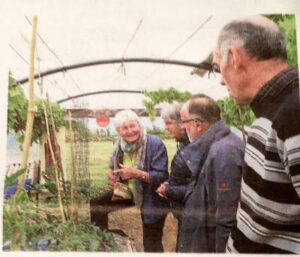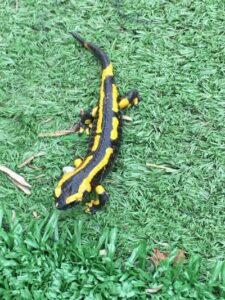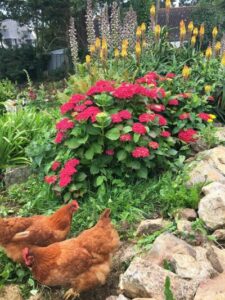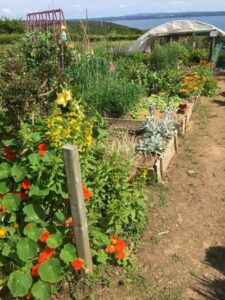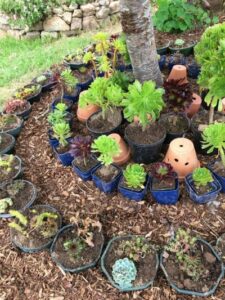I am a “Consecrated Lay Daughter of the Holy Spirit”. After having lived my professional life in Brest, a city in Brittany, France, I have been retired for 4 years in a village in Plougastel-Daoulas -near Brest-. A small studio, but a large garden. A very ordinary life, inserted in a village… I propose to share an experience around my garden, a garden that I work in the spirit of ‘Laudato Si’.
A milestone: the opening of the “Natural Garden” in June 2019, with a demonstration of how to make a vegetable garden using “lasagne” *. 250 to 300 visitors. All the neighbours in the front row! It was a great event in the village! Since then, some neighbours have taken up permaculture. And a deep network of neighbours has been built up through mutual aid, the sharing of experiences and advice, the exchange of cuttings/grafting, seeds and harvests (flowers, fruit, vegetables, etc.)
The unbelievable is simply experienced on a daily basis. Neighbours offer to mow their garden for mulching. “No need to go to the waste disposal centre! Jean Jacques, who has just shredded some old trees, offers the shredded material. Yvon regularly comes to saw pallet wood for heating. Catherine and François come with their grandchildren to see the chickens and we barter! Baptiste, knowing that there were aphids in the greenhouse, talks about it in his 5th grade class and, with the teacher, prepares a culture of ladybird larvae! In spring, Anne Marie gathers orders for plants that we cannot produce. Jean-Yves, through his connections, provides cardboard for the winter coat of soil. With Noël and Yvon we put a limit to the number of wild boars: we must protect the crops, toads and salamanders in the garden!
And what about sharing the vegetables and fruits when it’s time to pick them!
I have always loved the earth. I see it as the precious cradle of living beings, the unexpected full of promise. It is entrusted to us, it welcomes the present, sends us messages, it is up to us to observe and listen to it. This gives me the feeling of belonging to creation, with all living beings, and of deepening my sense of beauty.
What I live in this experience of closeness, in the light of ‘Laudato Si’, is renewing for my vocation. This interdependence makes me aware that everything is linked “by a tender divine affection”, as Pope Francis says. Relationship is at the heart of my life. It invites me to go out into the field, to dare to meet people, to live the taste of meeting. Relationships are forged. We are not just “neighbours” looking after the land. Joys and worries are shared. These links can go as far as sharing faith: recognising the God of Love who is close by…
My life is thought of in terms of presence and sharing, not in terms of utility. This life of closeness, of gratuitousness, of sobriety, is well in line with “integral ecology”. Doesn’t this simplicity of daily life match the hidden life of Jesus in Nazareth?
It is in this daily life that I live out my consecration. I have to watch over, be on the alert, make community in a different way: “The church on the move”. My poverty becomes an offering and my celibacy, this lack that no one can fill, is it not a path that can strengthen “the taste for the other”? (Elena Lasida) and lead to God? The happiness of these encounters fills me with joy and becomes my prayer, a little like “the life hidden in God” of which St Paul speaks.
All this experience is in line with what our Secular Branch statutes ask for: “Consecrated to God in the ordinary conditions of life…”, “welcoming each person, each creature and creation itself as the gift of a loving God…”, “we participate in the mission of the Church in the world by a simple, discreet presence, seeking to respond boldly to the calls of the Spirit in the places where we live.” …
Testimony of Marité Normand – consecrated lay person, Secular Branch DHS– Published on 15 May 2022
* The lasagna garden. As the name suggests, the principle of the lasagna garden is the same as that of the flat: different layers of material are alternated,
– Green waste: this is used to incorporate nitrogen into the lasagne. This includes kitchen waste, grass clippings, coffee grounds, manure,..
– Brown residues: these are used to add carbon to the lasagne: dead leaves, sawdust, wood chips, twigs, straw, etc.
